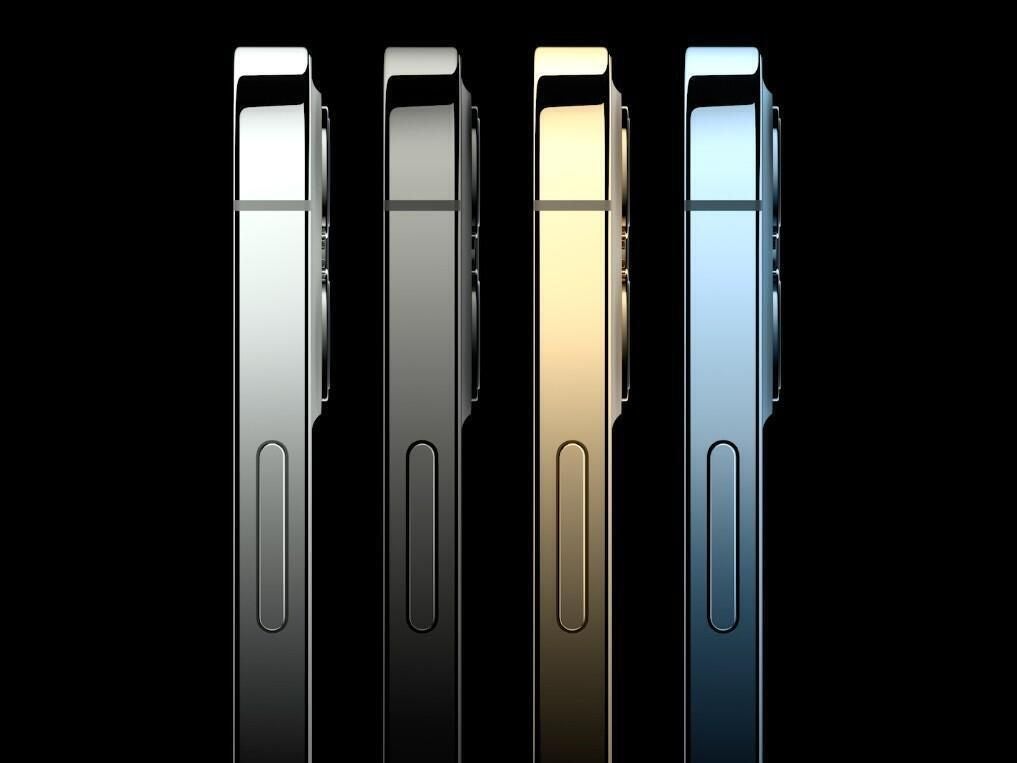2020 saw the release of four iPhones, all of which Apple revealed at a virtual launch event, and they have since become one of the most sold models around the world. The iPhone 12 mini, iPhone 12, iPhone 12 Pro, and iPhone 12 Pro Max come in different sizes, features and prices. Apple designed this lineup to reach a wide array of customers, meeting different needs and budgets. The four iPhone 12 models are also the first Apple phones to include 5G connectivity.
SEE: iPhone 12: A cheat sheet (free PDF) (TechRepublic)
Jump to:
- Fast facts at a glance
- iPhone 12 pricing: Model comparison chart
- New color and the AirTag
- iPhone 12 innovative features
- What are the key features of the iPhone 12 family?
- More features in the iPhone 12
- What are the differences between the four iPhone 12 models?
- What are the main competitors to iPhone 12?
- What is the target market for iPhone 12?
Fast facts at a glance
| At a glance | Features |
|---|---|
The iPhone 12 was Apple's top mobile phone for 2020. It is available in a 6.1-inch size, offers 5G, has an OLED display, has enhanced photography and cameras and comes with the A14 chip. |
|
iPhone 12 pricing: Model comparison chart
The iPhone 12 can be purchased at the official Apple Store, but models iPhone 12 mini, iPhone 12 Pro and iPhone 12 Pro Max are discontinued by Apple to favor the sale of their iPhone 13 and iPhone 14 models. These discontinued models are only available through third-party sellers.
Important note: The chart below shows official prices from the Apple Store for the iPhone 12 and prices from BestBuy. Phone prices may reflect pre-owned devices, and costs may change over time and vary depending on region and availability.
| Model | 64GB | 128GB | 256GB | 512GB |
|---|---|---|---|---|
| iPhone 12 mini | $419 | $449 | Not available | Not available |
| iPhone 12 | $599 | $649 | $749 | Not available |
| iPhone 12 Pro | Not available | $649 | $699 | $749 |
| iPhone 12 Pro Max | Not available | $640 | $699 | $899 |
New color and the AirTag
On April 20, 2021, Apple introduced a new color to complement its previous color offerings: purple (Figure A). The company from Cupertino said that the color accentuated the flat aluminum edges of the iPhone 12 and iPhone 12 mini.
Figure A
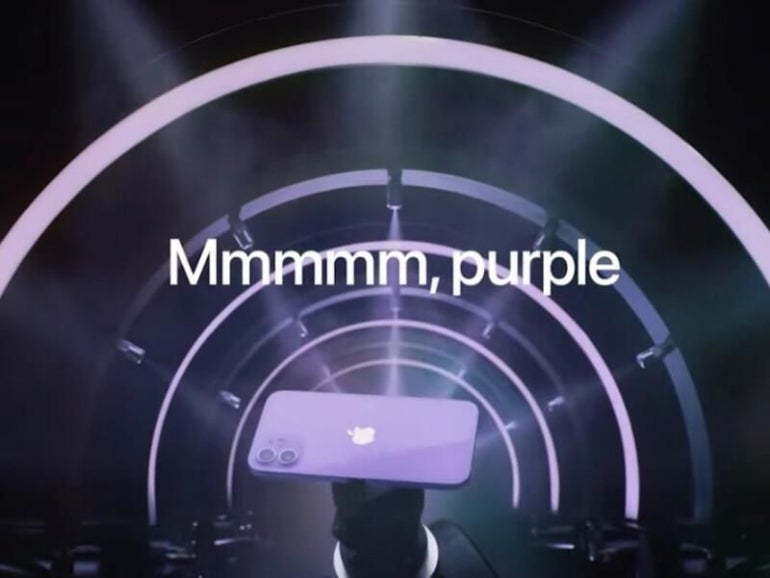
Apple also revealed the AirTag, a chip that helps users find items such as lost keys with Apple’s Find My app. The Air Tag is IP67 water- and dust-resistant. It has a built-in speaker that plays sounds to help locate the tags and a removable cover to make it easy for users to replace the battery.
AirTag features the same easy setup experience as AirPods. Users only have to bring the AirTag close to the iPhone, and it will connect. Users can assign an AirTag to an item and name it with defaults like “Keys” or “Purse”, or provide a custom name.
Customers can also add a free engraving to personalize tags, as well as an Apple-designed AirTag accessory, such as the Polyurethane Loop, the Leather Loop or the Leather Key Ring — featuring specially tanned European leather (Figure B).
Figure B

The AirTag is equipped with the U1 chip that uses ultra-wideband technology, enabling Precision Finding for iPhone 11 and iPhone 12 users. This technology makes it easier to more accurately determine the distance and direction to a lost AirTag when it’s in range. As a user moves, Precision Finding takes input from the camera, ARKit, accelerometer and gyroscope and then guides the user to the AirTag using a combination of sound, haptics and visual feedback (Figure C).
Figure C
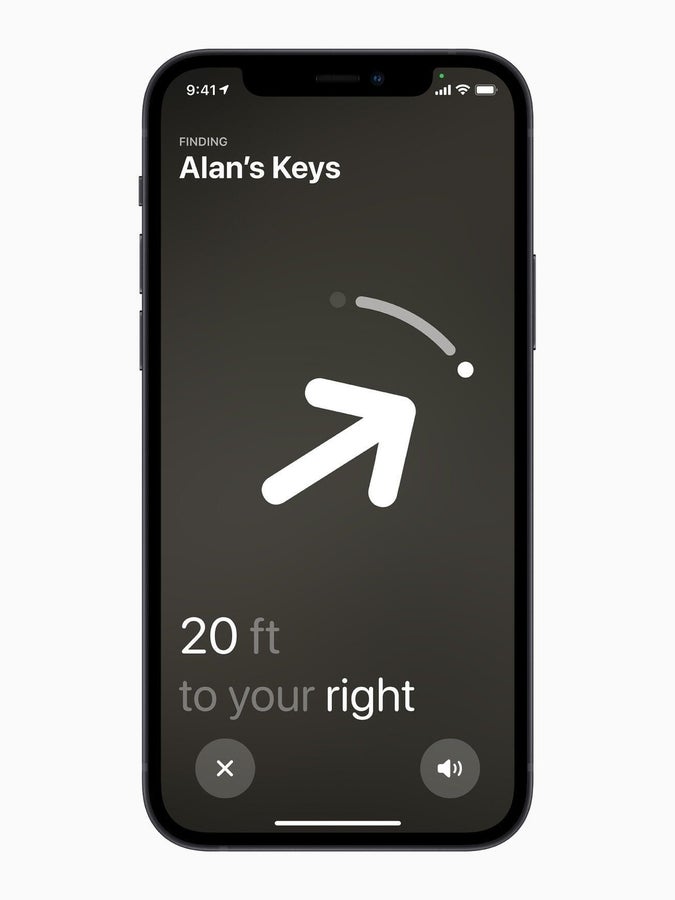
If the AirTag is out of Bluetooth range, the Find My network can still help the user locate a tagged item. Users can also place AirTag into Lost Mode and be notified when it is in range or has been located by the Find My network. If a lost AirTag is found, the finder can tap it using their own iPhone or any NFC-capable device and be taken to a website that will display the contact phone number of the owner.
Apple assures that no location data or location history is physically stored inside the AirTag. Communication with the Find My network is end-to-end encrypted. Only the owner of a device has access to its location data, and no one — including Apple — knows the identity or location of any device that helped find it.
iPhone 12 innovative features
Beyond adding 5G, Apple equipped the iPhone 12 family with the powerful A14 Bionic processor, a Super Retina XDR display, a more durable Ceramic Shield front cover, a MagSafe feature for more reliable wireless charging and support for attachable accessories (Figure D).
Figure D
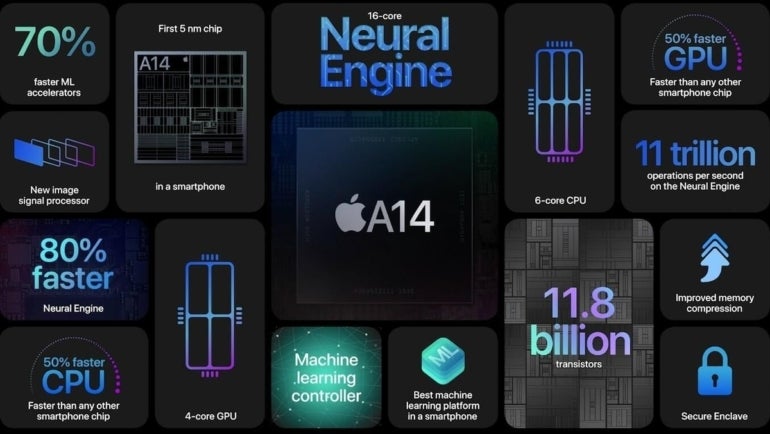
Cameras
Apple also beefed up the cameras for the iPhone 12 with an array of advanced features designed to enhance and fine-tune your photos and videos. The iPhone 12 mini and iPhone 12 come with a dual-camera system in the rear with wide and ultra-wide lenses. The iPhone 12 Pro and iPhone 12 Pro Max add a third telephoto lens, as well as a fourth lens for LiDAR augmented reality (AR) mapping.
SEE: How to migrate to a new iPad, iPhone, or Mac (TechRepublic Premium)
Other innovative camera features found in all four phones include Deep Fusion to flesh out more detail in low-light conditions, Smart HDR 3 to better balance all the elements in a scene and Night Mode Time Lapse for time-lapse photography at night. Plus, the two Pro models natively support shooting and editing photos in RAW format via the Apple ProRAW feature (Figure E).
Apple even changed the edges of the iPhone 12, reverting from the rounded edges found on the iPhone 11 to the flat-edged design of the old iPhone 5.
Figure E
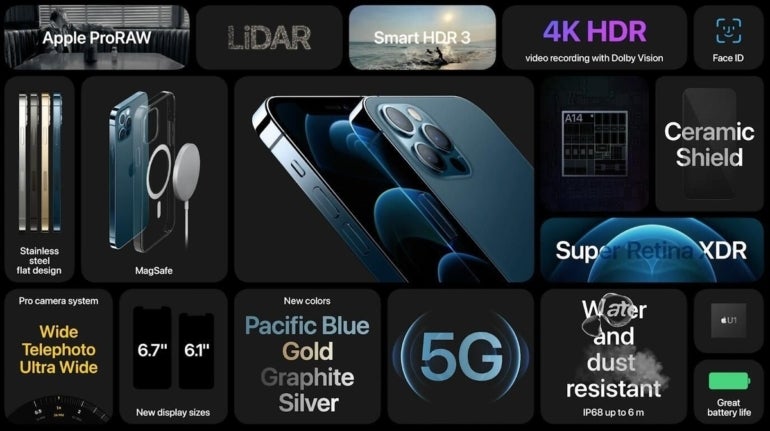
What are the key features of the iPhone 12 family?
5G
The 5G technology in all four iPhone 12 models supports both sub-6GHz and mmWave networks. The sub-6GHz spectrum is more pervasive, can travel farther and is more resistant to interference. But, it’s also more crowded, limiting its actual speed.
In contrast, mmWave is much faster but is more susceptible to interference and so works best only at close range to cell towers. In the U.S., AT&T, T-Mobile and Verizon Wireless offer both types of networks.
SEE: Explore key 5G trends to watch in 2023.
Adding 5G helped make the iPhone 12 lineup more future-proof. Because 5G can be a drain on the iPhone 12 battery, Apple introduced the Smart Data Mode feature. When 5G is not needed, the iPhone 12 automatically drills down to 4G.
Processor
The iPhone 12 lineup is powered by the A14 Bionic processor, which is also found in the 2020 iPad Air 4. The A14 was designed to improve performance and save battery life. The six-core processor has four high-efficiency cores and two high-performance cores.
Using a 5 nm process, this chip is home to 11.8 billion transistors, up from 8.5 billion compared to the A13 Bionic. The higher transistor count means that the A14 is not only faster but also more power-efficient. Moving from 8 to 16 cores, the A14’s neural engine can process 11 trillion operations per second, increasing the speed of computations and machine learning.
Display
All four iPhones sport OLED screens outfitted with Apple’s Super Retina XDR display and High Dynamic Range (HDR). Offering a 2,000,000:1 contrast ratio and 1,200 nits of maximum brightness, these were the most advanced screens ever built into an iPhone when released (Figure F). Taken together, these features provide excellent image quality, optimal energy efficiency, accurate colors and enhanced contrast over traditional LCD screens.
Figure F
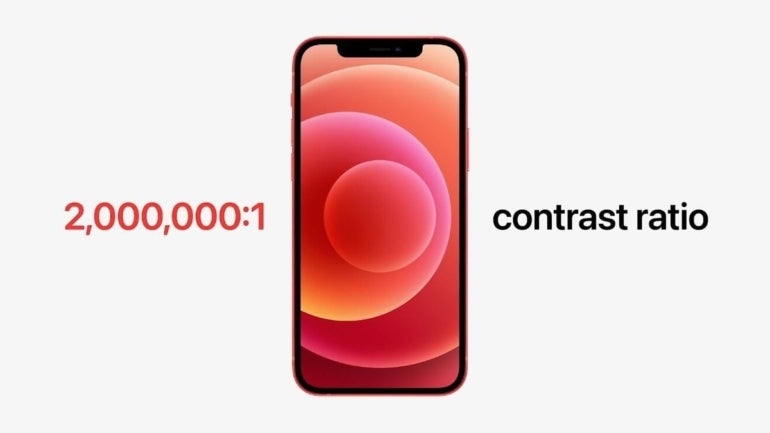
Ceramic Shield screen
Through a feature called Ceramic Shield, the iPhone 12 included ceramic in its front glass display, thus making the screen tougher and more drop-resistant. This process works by adding a high-temperature crystallization method that grows nano-ceramic crystals within the glass matrix. Based on Apple’s testing, Ceramic Shield increases the iPhone 12’s drop performance by four times more than the iPhone 11.
Rear cameras
The iPhone mini and iPhone 12 sport two 12-megapixel rear cameras — one wide and one ultrawide. The iPhone 12 Pro and iPhone 12 Pro Max have three 12-megapixel rear cameras — wide, ultrawide and telephoto. Plus, the two Pro models devote the fourth lens for LiDAR mapping to measure the distance and depth of objects more accurately, a feature of benefit to AR apps (Figure G). The wide camera boasts an ƒ/1.6 aperture, which Apple said when released, it would provide 27% more light in low-light conditions.
Figure G
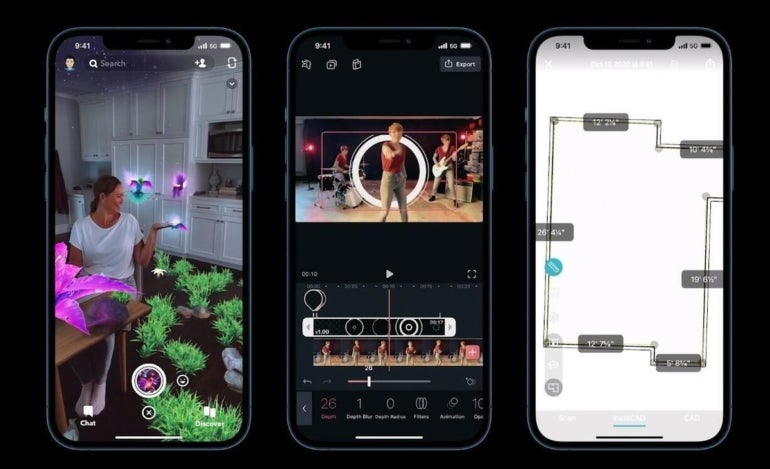
The 12-megapixel telephoto cameras found in the two iPhone 12 Pro models offer an ƒ/2.0 aperture with a 52mm focal length, a 4x or 5x optical zoom range and optical image stabilization.
On the video front, the rear cameras on the iPhone 12 mini and iPhone 12 can shoot HDR videos with Dolby Vision up to 30 fps, while the ones on the two Pro iPhone 12 models can shoot HDR videos with Dolby Vision up to 60 fps.
| Model | iPhone 12 mini | iPhone 12 | iPhone 12 Pro | iPhone 12 Pro Max |
|---|---|---|---|---|
| Rear cameras | Ultrawide: 12MP with ƒ/2.4 aperture and 120° field of view. Wide and Telephoto. Digital zoom up to 5x. Night mode (Ultra Wide and Wide). | Ultrawide: 12MP with ƒ/2.4 aperture and 120° field of view. Wide and Telephoto. Digital zoom up to 5x. Night mode (Ultra Wide and Wide). | Ultrawide: 12MP with ƒ/2.4 aperture and 120° field of view. Wide and Telephoto. Digital zoom up to 10x. Night mode enabled by LiDAR. Apple ProRAW. | Ultrawide: 12MP with ƒ/2.4 aperture and 120° field of view. Wide and Telephoto. Digital zoom up to 12x. Night mode enabled by LiDAR. Apple ProRAW. |
Front camera
The iPhone 12’s front-facing 12-megapixel camera offers an ƒ/2.2 aperture and can shoot HDR videos with Dolby Vision up to 30 fps.
| Model | iPhone 12 mini | iPhone 12 | iPhone 12 Pro | iPhone 12 Pro Max |
|---|---|---|---|---|
| Front camera | 12MP camera with ƒ/2.2 aperture. Night mode, Deep Fusion, Smart HDR 3 with Scene Detection. | 12MP camera with ƒ/2.2 aperture. Night mode, Deep Fusion, Smart HDR 3 with Scene Detection. | 12MP camera with ƒ/2.2 aperture. Night mode, Deep Fusion, Smart HDR 3 with Scene Detection. | 12MP camera with ƒ/2.2 aperture. Night mode, Deep Fusion, Smart HDR 3 with Scene Detection. |
QuickTake
Introduced with iOS 13 on the iPhone 11, the QuickTake feature lets users tap and hold the shutter button to take a quick video while they’re composing a regular still photo. That video then appears as a short clip in your Photos library.
Night mode
This camera mode is automatically enabled when it’s dark enough to use it, and it works with the camera sensors to make low-light photos pop. Night mode takes shorter and longer frames and merges them automatically for better low-light performance. All four iPhone 12 models incorporate Night mode on both the rear and front cameras. The Night mode Time-Lapse feature provides longer exposure times, better lighting and smoother exposure for time-lapse photography when the phone is on a tripod (Figure H).
Figure H

Smart HDR 3
The Smart HDR feature uses the camera sensors to capture better HDR shots and Portrait mode shots.
| Model | iPhone 12 mini | iPhone 12 | iPhone 12 Pro | iPhone 12 Pro Max |
|---|---|---|---|---|
| Sensors | Face ID, barometer, three‑axis gyro, accelerometer, proximity sensor and ambient light sensor. | Face ID, barometer, three‑axis gyro, accelerometer, proximity sensor and ambient light sensor. | Face ID, LiDAR Scanner, barometer, three‑axis gyro, accelerometer, proximity sensor and ambient light sensor. | Face ID, LiDAR Scanner, barometer, three‑axis gyro, accelerometer, proximity sensor and ambient light sensor. |
ApplePro Raw
Built into the iPhone 12 Pro and 12 Pro Max, this feature allows users to capture photos in RAW format with all the advanced camera tools and technologies to enhance the image. They can also edit ApplePro Raw images directly in the iPhone’s Photos app and other third-party apps.
Design
In a major design change, the iPhone 12 shifted away from the rounded edges of the iPhone 11 and reverted to the flat-edged shape last seen on the iPhone 5.
| Model | iPhone 12 mini | iPhone 12 | iPhone 12 Pro | iPhone 12 Pro Max |
|---|---|---|---|---|
| Design | Ceramic Shield front, glass back and aluminum design. | Ceramic Shield front, glass back and aluminum design. | Ceramic Shield front, textured matte glass back and stainless steel design. | Ceramic Shield front, textured matte glass back and stainless steel design. |
MagSafe
Introduced with the iPhone 12 lineup, MagSafe improves the wireless charging built into the phone for faster and more accurate charging. But there’s more: MagSafe also offers a magnetic base through which accessories can attach themselves to the phone. As one example, Apple has touted a MagSafe-compatible thin wallet that attaches itself to the back of the phone.
Battery
The batteries in the iPhone 12 models are 10% larger than the ones in the iPhone 11 due to the extra drain caused by 5G. The iPhone 12 Pro and Pro Max promise at least an hour longer of time on a single charge, but the iPhone 12 mini’s battery life is more limited due to its smaller size.
Colors
The iPhone 12 mini and iPhone 12 come in the traditional white and black but also in blue, green and red. On April 23, 2021, it became available in purple. The iPhone 12 Pro and 12 Pro Max are available in blue, gold, graphite and silver.
More features in the iPhone 12
The iPhone 12 family also includes these shared features:
- Wi-Fi 6 (802.11ax) for up to 38% faster download speeds.
- Better dust and water resistance: IP68 rating on iPhone 12 Pro for up to 4 meters of water at up to 30 minutes.
- Fast charging for up to 50% battery capacity in just 30 minutes.
- Audio sharing with two sets of AirPods to Beats headphones on a single iPhone.
- Spatial audio that simulates surround sound.
- Dolby Atmos that simulates sound moving around in a 3D space.
- Dual SIM with eSIM.
To keep the prices of the phones down and reduce the carbon footprint of accessories, Apple is selling the iPhone 12 without earbuds or charging plugs in the box. The only accessory in the box is the standard Lightning to USB-C cable. Apple also likely expects that many buyers already have earbuds and USB chargers on hand.
Figure I
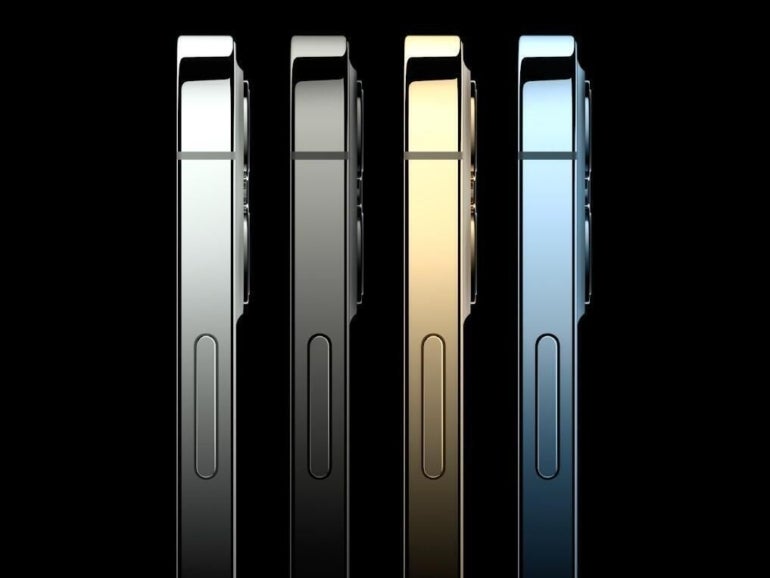
What are the differences between the four iPhone 12 models?
iPhone 12 mini
The baby of the bunch, the iPhone 12 mini offers a screen size of 5.4 inches and storage options of 64GB, 128GB and 256GB. The screen resolution is 2,340 x 1,080 pixels at 476 ppi. The phone incorporates Ceramic Shield on the front with a glass back and an aluminum design. The iPhone 12 mini uses a dual-camera system in the rear with a 12 MP wide and a 12 MP ultra-wide lens. It is offered in black, white, red, blue, green and purple.
iPhone 12
Next in line, the iPhone 12 has mostly the same specs as the iPhone 12 mini, but the iPhone 12 offers a 6.1-inch screen with a resolution of 2,532 x 1,170 pixels at 460 ppi and a starting price of $599.
iPhone 12 Pro
The iPhone 12 Pro also has a screen size of 6.1 inches with the same 2,532 x 1,170 pixel resolution but adds a variety of advanced features compared to the iPhone 12. The case uses a Ceramic Shield front with a textured matte glass back and stainless steel design. Storage options include 128GB, 256GB and 512GB. The three-camera system in the rear adds a 12 MP telephoto lens with an ƒ/2.0 aperture and a LiDAR scanner. The iPhone 12 Pro also supports Apple ProRAW for shooting and editing photos in RAW format.
iPhone 12 Pro Max
The king of the bunch, the iPhone 12 Pro Max is similar to the iPhone 12 Pro in most ways but offers a screen size of 6.7 inches with a resolution of 2,778 x 1,284 resolution at 458 ppi. The optical and digital zoom rates are also slightly higher than those of the iPhone 12 Pro.
| Model | iPhone 12 mini | iPhone 12 | iPhone 12 Pro | iPhone 12 Pro Max |
|---|---|---|---|---|
| Colors | Black, white, red, blue and green. | Black, white, red, blue and green. | Gold, silver, graphite, pacific and blue. | Gold, silver, graphite, pacific and blue. |
| Storage options | 64GB, 128GB and 256GB. | 64GB, 128GB and 256GB. | 128GB, 256GB and 512GB. | 128GB, 256GB and 512GB. |
| Size and weight | 5.18″ x 2.53″ x 0.29″ 4.76 ounces | 5.78″ x 2.82″ x 0.29″ 5.78 ounces | 5.78″ x 2.82″ x 0.29″ 6.66 ounces | 6.33″ x 3.07″ x 0.29″ 8.03 ounces |
| Display brightness | 625 nits max brightness (typical). | 625 nits max brightness (typical). | 800 nits max brightness (typical). | 800 nits max brightness (typical). |
| Display size | 5.4 inches | 6.1 inches | 6.1 inches | 6.7 inches |
| Display resolution | 2,340 x 1,080 pixel resolution at 476 ppi. | 2,532 x 1,170 pixel resolution at 460 ppi. | 2,532 x 1,170 pixel resolution at 460 ppi. | 2,778 x 1,284 pixel resolution at 458 ppi. |
What are the main competitors to the iPhone 12?
With all four iPhone 12 models offering different sizes and features at different prices, the competition is wide open.
iPhone 12 mini competition
Competing with the 5.4-inch iPhone 12 mini are such phones as the Samsung Galaxy S10e and the Google Pixel 4. The Galaxy S10e offers a 5.8-inch AMOLED screen with two rear cameras (wide and ultra-wide), face recognition and a fingerprint scanner. The Google Pixel 4 comes with a 5.7-inch OLED display, with wide-angle and telephoto cameras in the rear and facial recognition, but no fingerprint sensor. Neither phone includes 5G connectivity.
iPhone 12 and 12 Pro competition
Rivals to the iPhone 12 and iPhone 12 Pro encompass several of Samsung’s Galaxy phones, including the S10, S10 Plus, S20 and S20 FE. Among these Galaxy phones, only the S20 and S20 FE are 5G models. The Galaxy S10 has a 6.1-inch screen, and the S10 Plus bumps the screen size to 6.4 inches. The Galaxy S20 offers a 6.2-inch screen, while the S20 FE has a screen size of 6.5 inches.
Also built with 5G, Google’s Pixel 5 and Pixel 4A 5G are worth considering. The Google Pixel 5 includes a 6-inch screen, while the Pixel 4A 5G offers a screen size of 6.2 inches.
iPhone 12 Pro Max competition
Rivals to the iPhone 12 Pro Max are Samsung’s Galaxy S20 Plus, Galaxy S20 Ultra, Galaxy Note 20, and Galaxy Note 20 Ultra. The Galaxy S20 Plus comes with a 6.7-inch screen, while the S20 Ultra features a whopping 6.9-inch display. The Note 20 offers a 6.7-inch screen, while the Note 20 Ultra includes a 6.9-inch display.
SEE: All of TechRepublic’s cheat sheets and smart person’s guides
What is the target market for the iPhone 12?
The iPhone 12 family is designed for first-time buyers, as well as those looking to upgrade from an iPhone X or 11 model or older iPhones. But Apple is also naturally hoping to lure unsatisfied Android users who may be leaning toward an iPhone.
The iPhone 12 mini is targeted at budget-conscious consumers who are more comfortable with a smaller screen. Moving up the line, the iPhone 12 is geared toward buyers who crave a larger screen but don’t need all the bells and whistles of the Pro line. The iPhone 12 Pro and Pro Max are aimed at traditional consumers as well as photographers and videographers willing to pay extra not only for a large screen but also for the advanced camera lenses and other cutting-edge photographic features.
SEE: Mobile device security: Tips for IT pros (free PDF) (TechRepublic)
Visit TechRepublic Academy to find compatible accessories for your iPhone 12 at discounted rates:
